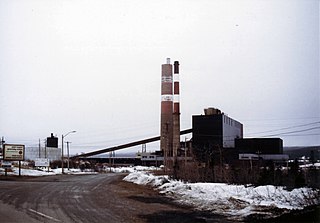
Cape Breton Regional Municipality is the Canadian province of Nova Scotia's second largest municipality and the economic heart of Cape Breton Island. As of 2021 the municipality has a population of 93,694. The municipality was created in 1995 through the amalgamation of eight municipalities located in Cape Breton County.

The Cape Breton and Central Nova Scotia Railway is a short line railway that operates in the Canadian province of Nova Scotia. CBNS operates of main line and associated spurs between Truro in the central part of the province to Point Tupper on Cape Breton Island.
The Société des chemins de fer du Québec (SCFQ), or Quebec Railway Corporation in English, is a former Canadian railway holding company that owned several short line railways in the provinces of Quebec, Ontario, New Brunswick and Nova Scotia.

The Sydney and Louisburg Railway (S&L) was a Canadian railway. Built to transport coal from various mines to the ports of Sydney and Louisbourg, the S&L operated in the eastern part of Cape Breton County, Nova Scotia. The railway uses a slightly different spelling for the town of "Louisbourg".
The Devco Railway was a Canadian railway. Devco Railway operated as an unincorporated department within the Coal Division of the Cape Breton Development Corporation, also known as DEVCO; as such there is no formally incorporated entity named "Devco Railway". Devco Railway took over the operations of the Sydney and Louisburg Railway on March 30, 1968 when DEVCO expropriated the S&L as part of the assets of the Dominion Steel and Coal Corporation, or DOSCO.

The Cape Breton Development Corporation, or DEVCO, was a Government of Canada Crown corporation. It ceased operation on December 31, 2009, after being amalgamated with Enterprise Cape Breton Corporation (ECBC).

Sydney Steel Corporation (SYSCO) was a Crown corporation in the province of Nova Scotia, Canada. It owned and operated a steel mill in Sydney.
Industrial Cape Breton is a geographic region in the Canadian province of Nova Scotia. It refers to the eastern portion of Cape Breton County fronting the Atlantic Ocean on the southeastern part of Cape Breton Island.

The Dominion Steel and Coal Corporation was a Canadian coal mining and steel manufacturing company.
Whitney Pier is an urban neighbourhood in Sydney, Nova Scotia, Canada. Prior to the 20th century, this area was known as “Eastmount” or “South Sydney Harbour,” and had long been a fishing and farming district. It is a triangle-shaped area North of the Muggah Creek estuary running along the Eastern shore of Sydney Harbour.
The Cumberland Railway and Coal Company is a defunct Canadian industrial company with interests in coal mines in Springhill, Nova Scotia, and a railway that operated from Springhill Junction to Parrsboro.
TrentonWorks is an industrial manufacturing facility located in the town of Trenton, Nova Scotia, Canada.
Lingan (is a Canadian suburban community in Nova Scotia's Cape Breton Regional Municipality. Its population in 2021 was 229.

The Lingan Generating Station is a 620 MW Canadian coal-fired electrical generating station located in the community of Lingan in Nova Scotia's Cape Breton Regional Municipality. Lingan is operated by Nova Scotia Power Inc. and is their largest generating station.

The Trenton Generating Station or Trenton GS is a 310 MW Canadian thermal generating station located in the town of Trenton, Nova Scotia.

Point Aconi is a rural community in Nova Scotia at the northeastern tip of Boularderie Island. It derives its name from the headland of the same name, Point Aconi.
The Cape Breton coal strike of 1981 was a strike by coal miners who were members of the United Mine Workers of America (UMW) District 26 against the Cape Breton Development Corporation (DEVCO) of Cape Breton Island, Nova Scotia, Canada. It was the first strike by District 26 since 1947. The high double-digit inflation of the late 1970s and early 1980s affected the buying power for the miners. The strike, which was bitter and violent, began on July 17, 1981. It ended on October 8, 1981 after the fourth contract vote.

The Point Aconi Generating Station is a 165 MW Canadian electrical generating station located in the community of Point Aconi, Nova Scotia, a rural community in the Cape Breton Regional Municipality. A thermal generating station, the Point Aconi Generating Station is owned and operated by Nova Scotia Power Corporation. It opened on August 13, 1994 following four years of construction.
Victoria Junction is a community in the Canadian province of Nova Scotia, located in the Cape Breton Regional Municipality.

The Point Tupper Generating Station is a 150 MW Canadian electrical generating station located in the community of Point Tupper in Richmond County, Nova Scotia.











